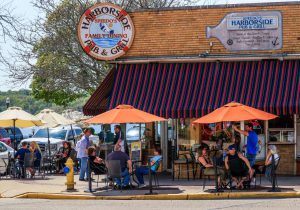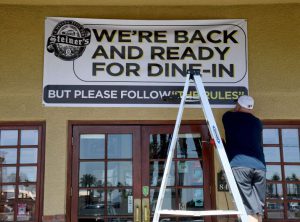MAY 22, 2020

People sit last week at outdoor restaurant tables in Lake Geneva, Wis. A study shows that the coronavirus may be continuing to spread in 24 states, including Wisconsin. – Tannen Maury/EPA-EFE/Shutterstock
The coronavirus may still be spreading at epidemic rates in 24 states, particularly in the South and Midwest, according to new research that highlights the risk of a second wave of infections in places that reopen too quickly or without sufficient precautions.
Researchers at Imperial College London created a model that incorporates cellphone data showing that people sharply reduced their movements after stay-at-home orders were broadly imposed in March. With restrictions now easing and mobility increasing with the approach of Memorial Day and the unofficial start of summer, the researchers developed an estimate of viral spread as of May 17.
It is a snapshot of a transitional moment in the pandemic and captures the patchwork nature across the country of covid-19, the disease caused by the virus. Some states have had little viral spread or “crushed the curve” to a great degree and have some wiggle room to reopen their economies without generating a new epidemic-level surge in cases. Others are nowhere near containing the virus.
The model, which has not been peer reviewed, shows that in the majority of states, a second wave looms if people abandon efforts to mitigate the viral spread.
“There’s evidence that the U.S. is not under control, as an entire country,” said Samir Bhatt, a senior lecturer in geostatistics at Imperial College.
The model shows potentially ominous scenarios if people move around as they did previously and do so without taking precautions. In California and Florida, the death rate could spike to roughly 1,000 a day by July without efforts to mitigate the spread, according to the report.
Other models released in recent days captured a similarly mixed picture. The PolicyLab at Children’s Hospital of Philadelphia used county-level forecasts that found much of the country was in decent shape for reopening, but worrisome areas remain, including Houston, Dallas, South Florida and Alabama.
On this Memorial Day weekend, some people will visit areas that may not have had much exposure to the virus, said David Rubin, director of PolicyLab.
“This is the first test of the system,” Rubin said. “Those areas that succeed this weekend are going to succeed because they’ve developed strong regulations on how they’re going to do this.”

General manager Carlos Crow hangs a sign at Steiner’s, A Nevada Style Pub shortly before opening for business for the first time since closing on March 17 in response to the coronavirus pandemic on May 22, in Las Vegas, Nevada.
The Imperial College researchers estimated the virus’s reproduction number, known as R0, or R naught. This is the average number of infections generated by each infected person in a vulnerable population. The researchers found the reproduction number has dropped below 1 in the District and 26 states. In those places, as of May 17, the epidemic was waning.
In 24 states, however, the model shows a reproduction number over 1. Texas tops the list, followed by Arizona, Illinois, Colorado, Ohio, Minnesota, Indiana, Iowa, Alabama and Wisconsin.
When the R naught is below 1, it means the virus is hitting a lot of dead ends as it infects people. Someone who is infected but who follows social distancing rules or stays quarantined until recovering has a good chance of not infecting anyone else. The challenge is finding a way to reopen the economy with sufficient care to prevent the reproduction number from going over 1.
This has become a geographically complex pandemic, one that will evolve, especially as people increase their movements in coming weeks. Laws and health regulations vary from state to state, county to county and city to city. There are communities where wearing facial coverings is culturally the norm, while in other places it is rejected on grounds of personal liberty or as refutation of the consensus view of the hazards posed by the virus.
Political leaders have traded executive orders for appeals to individual responsibility and judgment. Even as they touted reopening water parks and beaches, some governors told their citizens not to enjoy their new freedoms too much.
In a hotspot in western Iowa, “families need to make their own decisions,” said Matthew A. Ung, chair of Woodbury County’s board of supervisors. “You don’t have to act one way or another because of what the government says,” he said. “Look out for you and your family.”
About 250 miles away in Minneapolis, municipal leaders are not counting on individual responsibility alone. The mayor, Jacob Frey, this week signed an emergency regulation requiring people older than 2 to cover their faces while at “indoor spaces of public accommodation,” including schools and government buildings.
“We are not criminalizing forgetfulness, but we will be cracking down on extreme selfishness and disregard for the health and safety of fellow Minneapolis residents,” Frey said in an interview.
Minnesota Gov. Tim Walz (D) this week said he would allow only alfresco dining when restaurants and bars resume in-person service June 1. That led to an outcry from owners who said they had been preparing for weeks to seat people inside, setting up plexiglass partitions and purchasing special filters to arrest tiny particles.
“None of us believed it was going to be patio only, especially in Minnesota when it rains all summer long,” said Brian Ingram, the owner of Hope Breakfast Bar in St. Paul, a popular joint known for its mantra, “Believe in Breakfast.”
In Mississippi, where the Imperial College model predicts infections are on the rise, Gov. Tate Reeves (R) said he was ready to reopen the last few businesses that remain closed in the state — including racetracks and water parks.
“We will be out of the business of closing down anybody, I hope,” Reeves said. But he said that in consultation with public health officials, he is keeping restrictions on seven counties with higher case loads.
In a news conference Thursday, Alabama Gov. Kay Ivey (R) defended her decision to reopen concert venues, movie theaters and other businesses despite rising case numbers.
“We cannot sustain a delayed way of life as we search for a vaccine,” she said. “Having a life means having a livelihood, too.”
That said, she promised that “if we start going in the wrong direction, we reserve the right to come back in and reverse.”
The Tennessee Emergency Management Agency said the state is preparing for a potential surge by increasing testing and constructing a 401-bed covid-19 care site in Memphis that was finished this week. David Aronoff, director of the Vanderbilt University infectious disease division, said the medical school is working with the state to track hospitalizations and deaths and is monitoring for a second surge.
“We’re watching for that really closely, but we haven’t seen that just yet, which is reassuring,” he said.
Experts in Tennessee are also concerned about people from other states beginning to flock to Nashville and Memphis on summer vacations. If a surge happens, Aronoff said, “the tricky part will be putting the toothpaste back in the tube” by shutting down again.
In Texas, Dallas County Judge Clay Jenkins said he consults with doctors and experts from area hospitals, “and what they tell us is that we’re reopening too fast, and we’re reopening in the wrong order.”
Local jurisdictions in Texas do not have the authority to issue more stringent restrictions than the state, which began aggressively reopening this month. So Dallas has focused on messaging. The county has a daily “covid-19 risk level” that is currently red, for “stay home, stay safe.” Officials are working on seals that businesses can display to indicate they are meeting local public health guidelines, not just state mandates.
The Imperial College estimates for Texas are in line with internal modeling conducted by university experts advising state leaders.
Rebecca Fischer, an epidemiologist at Texas A&M University and part of a team partnering with the governor’s office, said the daily caseload was fluctuating, but “it looks like we’re not cresting a peak and coming down the other side.”
A week ago, Texas reported a single-day high in new cases as well as deaths — about 14 days after the beginning of the state’s phased reopening. The state has now reported more than 52,000 cases and nearly 1,500 deaths.
Courtesy/Source: Washington Post

































































































